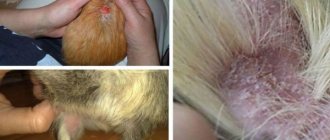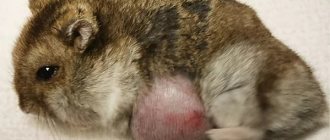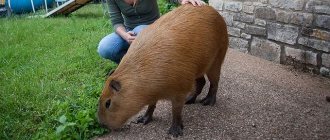Do hamsters have fleas? How to understand that a hamster is infected with parasites. Symptoms and causes of infection. Danger for hamsters when infected with fleas. What measures need to be taken. Correct methods of treatment. Mandatory measures when fighting fleas.
We try to care for our pets, please them in every possible way and try to protect them from all problems. But, unfortunately, it happens that our pets are attacked by parasites.
We all know that most often dogs and cats become infected with fleas, but when we see that the hamster begins to itch intensely, the question arises whether the problem can affect them. Here, owners should know that hamsters have fleas just like other animals. It is necessary to take measures as quickly as possible to avoid complications.
What fleas can a hamster have?
There are many types:
- rabbit;
- canine;
- feline;
- bird;
- rat.
These species will not strictly follow their name and bite only “their” type of animal. The main thing for them is the warm-bloodedness of the owner.
Hamsters have different fleas. The most common is the cat flea. They are the ones that often fall on hamsters. Often the cat becomes the carrier.
The hamster is too small to be a permanent home for fleas. They are transit passengers.
By the way, only adult bloodsuckers feed on blood.
Where to begin
At the first examination of the animal, it is very difficult to determine if the hamster has fleas. These very small, cute and at the same time cute creatures do not litter the apartment, are pleasing to the eye and are very popular with all family members, young and old.
How do fleas appear on hamsters and how do these “fluffy balls” become flea infested? We often confuse flea symptoms in these rodents with skin diseases of animals. Based on this, you can accurately determine whether a hamster has a parasitic disease by performing a visual examination of the animal. You can even see parasites on the skin of a rodent with the naked eye. Fleas on Djungarian hamsters are somewhat more difficult to notice, given the dark color of the rodent and its small size. Take a close look at the animal's fur coat - the presence of very small moving black dots is confirmation that the hamster has fleas. And this, in turn, is a positive answer to the question of whether hamsters have fleas.
If your eyesight is rather weak and this prevents you from seeing the flea, it is worth looking for other signs of confirmation of parasites in your pet rodent. These are:
- animal anxiety;
- the presence of dandruff in a woolen coat;
- in some areas the animal loses its fur;
- There are strong scratches on the hamster's body.
All these signs will help give an accurate answer whether hamsters have fleas.
Routes of infection
Main sources:
- Rodents. The hamster often comes into contact with them in a pet store or at the market. Sometimes mice and rats can live in a private home.
- Pets. Often dogs and cats bring bloodsuckers from the street.
- Shoes. Parasites can be accidentally brought in from the street by the owner himself. Eggs can easily get on your shoes. If wet cleaning is rarely carried out in the home, parasites can easily establish entire colonies.
- Grass. In the summer, hamsters are often pampered with fresh, juicy grass. Larvae and eggs may remain on it. Wash thoroughly before giving it to your baby.
Eye diseases
Due to their physiological characteristics, Syrian and Djungarian hamsters (as well as representatives of other species) often suffer from ophthalmological pathologies. One of the most common diseases is conjunctivitis (allergic, serous, purulent). Animals are also susceptible to cataracts, glaucoma, and uveitis (inflammation of the choroid).
You can tell if your hamster is sick by the following signs:
- spasmodic closing of the eyelids (spasm of the orbicularis oculi muscle);
- increased lacrimation;
- swelling;
- redness of the eyes;
- mucous or purulent discharge;
- sticking of eyelids.
If such symptoms appear, you should contact your doctor.
It is important to identify the causative agent of the disease (viruses or bacteria) and select appropriate drugs. Usually eye diseases in hamsters are treated with drops or ointments.
Bacteriostatic solutions (Sulfacetamide, Sofradex) and Tetracycline ointment are often used for this purpose.
In advanced cases, the veterinarian will prescribe an antibiotic for the hamster. And vitamin preparations help boost immunity, speed up recovery, and prevent relapse of eye disease. In the initial stages, you can use chamomile decoction or Furacilin solution.
In the absence of timely treatment, the risk of developing a purulent process, visual impairment or complete blindness increases.
Tumors, boils and abscesses
Often, ulcers and neoplasms of a benign or malignant nature are detected in rodents. These could be bumps on the body or a growth in the ear. Pathological formations may appear if the hamster fell from a height, was injured during a fight with relatives, or was attacked by other animals.
To understand the cause of the tumor, you need to show your pet to a veterinarian.
An abscess in a hamster can form from a regular scratch or small wound. After infection penetrates, pus accumulates in the affected area (under the skin). The abscess looks like a swelling that causes pain when pressed. An abscess can form due to prolonged inflammation of the cheek pouches. The disease is treated surgically.
Often, rodent owners worry about why their hamster has large testicles. More often this phenomenon is normal and indicates readiness for reproduction. But sometimes enlargement of the genital organs is associated with illness:
- the eggs became swollen and their size became more than ¼ of the animal’s body;
- testicles interfere with walking;
- the animal is lethargic, eats poorly, passive;
- the testicles turned red and became hot to the touch;
- the hair on the genitals has completely fallen out;
- hamster tries to gnaw testicles.
If such symptoms appear, you should immediately take your pet to the doctor. Especially if the appearance of alarming signs was preceded by a fall, severe bruise or other injury.
Oncological formations are treated surgically. The sooner the surgery is performed, the greater the chance of a full recovery. If metastases appear, the pet will have to be euthanized. The same should be done if the tumor is localized in a hard-to-reach place, for example in the mouth.
Symptoms of fleas in hamsters
Owners need to be very careful not to miss the characteristic symptoms. Since hamsters are very clean, they constantly lick, comb out their fur, and wash themselves.
Flea saliva contains enzymes that prevent blood from clotting. Swelling, inflammation, and itching appear where the bite was.
The hamster jumps up sharply and twitches. This is a sure sign of a bloodsucker attack. After it, the animal actively washes itself and itches.
Symptoms:
- The animal itches intensely and washes itself.
- Scratching, bald spots. Problems appear on the skin. A characteristic symptom is scratching and wounds. With constant itching, the hamster injures itself. His claws leave painful wounds. They become infected and fester. Areas of baldness appear on your pet's fur coat.
- You can find the parasite itself or its feces in the fur. Examine the skin carefully. When affected, there are characteristic dark dense grains. This is excrement, undigested blood. The insects themselves are more difficult to find.
whether Djungarian hamsters have fleas . Only a very observant owner can find a bloodsucker in such a fluffy baby. However, there are tricks. In Djungarians, fleas are often found on the neck and in the armpits. The animals are very fluffy and small, making it especially difficult to detect parasites on them. Syrian hamsters are larger. These pets are easier to examine. If you suspect the presence of parasites, it is better to show your baby to a veterinarian. He will examine it more competently and accurately identify the infection.
The behavior of an infected animal will not change immediately. Only with severe damage is it easy for the owner to notice changes. Itching appears gradually.
Since fleas jump easily, they will not sit on the rodent all the time. They will wander into the cage, and out of it throughout the home. People may also feel the bites of the annoying bloodsuckers.
Only a specialist can determine the presence of bloodsuckers by indirect signs. The owner can say for sure that there are fleas only if he has seen an adult parasite with his own eyes.
general description
If we talk about parasites such as fleas, it should be said that there are a huge number of varieties. For example, cats, dogs, mice and many others. But the fact is that they all have a fairly good appetite and, in search of food, do not go overboard when choosing a victim. So, a hungry dog flea can bite absolutely all warm-blooded animals.
Regarding the most common parasites, these include the cat flea. She can also attack hamsters, but only to satisfy her hunger. They do not take root on little furry friends, so after satisfying their hunger, they most often leave it. But parasites such as rats and mice pose a very great danger to animals.
Why are fleas dangerous for rodents?
If your hamster has fleas, you need to decide what to do as quickly as possible. It is better to show your pet to a veterinarian. Flea infestation is not fatal, but it poses a potential threat:
- Infection. The tiny bloodsucker is capable of infecting its host with dangerous infectious diseases (typhoid, salmonellosis, even the forgotten plague). Abscesses may develop on the skin.
- Worms. The animal constantly bites bloodsuckers out of dirty fur. This increases the risk of catching helminths. Therefore, veterinarians recommend giving an anthelmintic to your pet after removing fleas (“Shustrik”, etc.).
- Stress. Bloodsuckers greatly irritate the animal. The hamster cannot eat normally or sleep properly. He is nervous and losing weight.
How to get rid of fleas on a hamster's fur
At the moment, not every owner of a small rodent knows what to do if the hamster has various types of fleas. In this case, the pet owner does not need to panic, but should immediately contact the veterinarian who treats the animals.
It is the doctor who prescribes specific anti-flea medications. Then the pet owner buys ready-made insecticidal preparations.
Modern manufacturers produce a variety of insecticidal products. This allows the buyer to choose those drugs that are most convenient to use.
Treating all pets and your home for fleas
When fleas appear in an apartment, the tenant treats both all pets and the apartment itself.
When sanitizing a room in which fleas live on hamsters, the tenant performs the following actions:
- thoroughly vacuums his home, and then shakes out the vacuum cleaner (or throws out the disposable dust bag). A household member carries out such cleaning every day or at least 2 times in 7 days;
- vacuums a sofa or other furniture on which a cat or dog is sleeping, as well as carpets and dusty corners;
- After using the vacuum cleaner, he does a wet, thorough cleaning of his home.
When sanitizing his private household or apartment, a household member uses various insecticidal powders for indoor carpets or sprays (Raid, Combat, Raptor).
Then the pet owner dilutes 1 ampoule of this product (5 ml) with 3 liters of water and treats their home using a spray bottle.
When carrying out hamster sanitation, you need to keep in mind the following nuances:
- anti-flea sprays are effective for 2 weeks - 5 months;
- insecticidal drops are valid for a maximum of 1 month. They are designed for the specific weight of the pet. The household member squeezes the contents of the tube onto the skin of the cat or dog’s withers;
- Special flea shampoos have a short shelf life. Therefore, they are used only if fleas have already appeared on a cat or dog.
After the first treatment with insecticidal shampoo, the pet owner puts an anti-flea collar on the pet.
Hamster handling
Even if there are no cats or dogs in the house, hamsters still have fleas. In the event of a flea infestation, the rodent cannot avoid undergoing unpleasant disinsection. However, today there are practically no highly effective anti-flea products for such animals on sale.
Sellers of veterinary pharmacies often offer their clients those drugs that are made for dogs and cats, but their size is much larger than such rodents. After all, a hamster weighs approximately 50 grams.
This doctor prescribes the following highly effective anti-flea drugs for the hamster:
- aerosols;
- drops;
- powders.
Aerosol
When treating a hamster infected with fleas, its owner uses the following aerosols:
- "Bars" - fipronil 0.3%. To get rid of hamster fleas forever, the resident sprays 0.25 ml of this product on the rodent (presses the dispenser once);
- "BioVax";
- “Le Artist” is made from various plant components.
In such a situation, the resident sprays this product evenly over the hamster. Also, the owner of the animal sprinkles it on a cotton pad, and then wipes it over his pet, lifting its fur.
Drops
The drops are also a highly effective flea treatment for hamsters. When using this drug, the owner of the hamster drips 2-5 drops onto his withers and along the hamster's spine.
When treating a hamster for fleas, its owner uses the following drops:
- Celandine;
- Stronghold;
- Frontline;
- Petvital Canina Verminex.
Such insecticides not only instantly kill fleas, but also prevent re-infection of the hamster.
Powder
Not every rodent owner knows how to properly remove fleas from a hamster. This can be done using an insecticidal special powder such as anti-flea powder.
When this product is used correctly, the household powders and cleans the hamster’s fur, and then the small pests quickly die. Moreover, this powder is made of soft small particles that do not damage the hamster’s skin.
When treating a sick hamster, a household member uses the following powders:
- Savic Blue Cloud Dust (Savik);
- Insectal.
The powder is distributed in a thin layer over the entire body of the hamster (pollination occurs). The main thing is not to get into the hamster's mouth and nose.
Cage disinfestation
In addition to carrying out anti-flea treatment on the hamster itself at home, you also need to change its bedding - from old to new. Moreover, you can, for example, use a bedding made of cedar shavings, which repel fleas.
The cage and hamster accessories are thoroughly washed with hot running water and soap once every 7 days.
IS IT POSSIBLE TO BATH HAMSTERS? DO HAMSTERS HAVE FLEAS?
Treatment of fleas in hamsters
Treatment must be timely and thoughtful. Hamsters are very small and easy to harm. It is important to rule out other problems with similar symptoms, such as skin diseases. Only a veterinarian can accurately diagnose.
To effectively remove fleas, their life cycle must be taken into account. Most of the population (90%) live in the external environment.
You should start with the room and other pets. Be sure to replace all of the hamster cage litter. This is where the eggs are located. They are very small and invisible, so don't even try to find them.
Wash all the equipment and the cage itself thoroughly. Take the time to treat them thoroughly with an insecticide. Aerosols are very convenient.
Don't forget to rinse everything you processed. Residues of the poison used can seriously harm the health of the hamster. After 10-14 days, it is better to repeat the treatment, especially with severe infection.
Rodent processing
How to remove fleas from a hamster must be decided by a veterinarian. It is not always necessary to treat the rodent directly. Sometimes it is enough to wash the cage, equipment, wet clean the room, and vacuum. Only a veterinarian can accurately determine whether an animal needs to be treated.
If you no longer have pets, and your hamster is found to have fleas, then it should be treated.
Finding a good treatment for hamsters is difficult. Stores often offer products for cats and dogs. But their size is significantly different. Djungarians, for example, generally weigh up to 50 grams.
A veterinarian or veterinarian should select a flea remedy for a rodent. The dose of the drug is carefully calculated. It directly depends on the weight of the hamster. Most often prescribed:
- Injections. Ivermectin subcutaneously. You should try external treatment first.
- Sprays (“BioVax”, “Bars”). Since the animal is small, it is better to spray a cotton pad and then wipe the pet’s delicate skin with it, carefully lifting the fur.
- Insecticidal powder (“Clandestine”, “Insectal”). The powder must be thoroughly rubbed into the skin (against the growth of the coat).
Before using the drug, carefully read the instructions. Follow your veterinarian's recommendations strictly.
If you are not sure whether Djungarians have fleas , we can confirm for sure. Djungarian hamsters have fleas. Treatment is the same as for other types.
Along with the hamster, all four-legged pets need to be treated.
Remember that you cannot:
- Wet the hamster's fur, and even more so, wash it using anti-flea shampoo.
- Apply special anti-flea drops for dogs and cats into the withers area. There are no such drops to save rodents.
Cell disinfection
The treatment of the cage itself should begin with replacing the bedding. This is where most of the parasites, their larvae and eggs live. It is better to pour shavings from coniferous trees. Their smell repels insects. Cedar works very well.
Once every 7 days, accessories and the cage should be thoroughly washed with soap and hot water.
Treatment of housing and other pets
It is very important to first treat the room and other pets, and only then begin to treat the hamster.
Cleaning the premises
A vacuum cleaner is your best friend in preventing and controlling insects. Use it as directed at least twice a week. Don't forget to empty the bag immediately. If you use a disposable one, get rid of it immediately. You can clean it at least every day. Go through upholstered furniture, carpets, and corners with accumulated dust as thoroughly as possible. Clean thoroughly where your dog or cat spends the night.
Then a damp, thorough cleaning is carried out. Don't forget to add insecticides to the water for treating carpets (Raid, Kombat, Raptor). For baseboards and cracks, it is better to use an insecticide in a spray. Alternatively, you can use Neostomazan. This is a concentrated drug (1 ampoule is diluted for 3 liters). Treat the room with it using a spray bottle.
Be very careful when cleaning the perimeter of the floor and all floor coverings. It is better to beat the carpets well and dry them in the sun. You can take them to the laundry.
When cleaning the premises, there should be no people or animals there.
Gastrointestinal diseases
There are various diseases of hamsters that are caused by pathogenic microorganisms. Among them, veterinarians identify pathologies of the digestive tract. They cause gastrointestinal disorders, and in severe cases can lead to the death of the animal.
Worms are also common in hamsters, which enter the body along with contaminated food or water. The disease can be determined by the slow growth of young animals, sudden weight loss (with normal nutrition), problems with fur (for example, oily sheen)
It is also worth paying attention to the consistency of the stool: it becomes soft, the mass contains blood, mucus or fragments of parasites
Colibacillosis
This disease in hamsters is caused by E. coli. Colibacillosis is also called “wet tail”. This is because loose stools cause the fur around the hamster's anus to be wet.
The disease occurs as a result of the penetration of E. coli into the body. The source of infection is contaminated food or water.
You can tell that your hamster has colibacillosis by the following symptoms:
- watery diarrhea with a pungent odor;
- decrease or disappearance of appetite;
- weight loss;
- anxiety;
- depression, lethargy, apathetic state;
- exhaustion of the body;
- sometimes high temperature;
- uncertain movements;
- increased heart rate and breathing.
Specific signs of colibacellosis are loose stools and wet fur around the anus. The hamster is constantly trying to find a secluded place and curl up into a ball. He looks sloppy, his fur is disheveled, his ears are flattened, he doesn't move much.
The disease develops quickly, so treatment must be started in the early stages. Therapy is carried out under the supervision of the attending physician. The infection should be treated with electrolyte solutions and antibiotics (tetracyclines are often used). The former improve the hydration process, while the latter destroy bacteria in the intestines.
Therapy is carried out at home. During the treatment period, you must follow the diet prescribed by the ratologist.
Escherichia coli
Hamster diseases caused by E. coli can lead to the death of the pet. The infection begins to develop after a pathogenic microorganism enters the animal’s body, which begins to multiply rapidly. Because of this, the natural intestinal microflora changes, and the hamster’s condition deteriorates sharply.
Signs of an illness caused by E. coli:
- high body temperature;
- diarrhea with blood streaks;
- weakness, apathy;
- the animal does not eat anything;
- weight loss;
- blanching of the mucous membranes.
The infection progresses quickly and often ends in the death of the animal. To prevent this from happening, when the first symptoms of the disease appear, you need to contact a ratologist. The doctor will prescribe a bacteriological analysis to identify the pathogen and develop treatment tactics. Intestinal antiseptics and antibiotics will help destroy the source of infection.
You can get E. coli from a sick hamster. To avoid this, a person should thoroughly wash their hands with soap after contact with the animal. To prevent illness, you should keep your home clean.
Enteritis
This is a disease in which the inflammatory process affects the small intestine (some parts or all of it). As a result, its functionality is impaired, and dystrophic changes appear on the mucous membrane. Then various digestive disorders arise.
The main reason for the development of enteritis in a hamster is considered to be the lack of hay in its diet. The disease is manifested by increased gas formation in the intestines and diarrhea.
Enteritis is treated by introducing high quality hay into the hamster's diet. Specific therapy is also carried out: the feces of a healthy animal are diluted with water, and then administered through an enema into the patient’s intestines.
Preventing fleas in a hamster
It is much easier to prevent such a dangerous appearance of bloodsuckers than to fight them later. Prevention measures are simple:
- Clean often.
- Carpets, upholstered furniture, and floors must be thoroughly vacuumed.
- In summer, it is better to regularly apply special flea drops to your hamster’s fur.
- Wear a flea collar on animals that you take outside.
- Place a sprig of wormwood in the basement. Bloodsuckers really don't like this plant. It contains repellents - pyrethrins.
- It is better to bake the filler in the oven before use. Parasites are able to settle in it even in a warehouse or store.
Preventive measures
In order to prevent the spread of fleas in a private household or apartment, the tenant performs the following actions:
- regularly examines the hamster for the presence of bloodsuckers in its fur;
- uses specific plants that smell strongly (for example, wormwood). Then the household member lays out this grass near the cage. The fragrant smell of wormwood does not affect the hamster in any way, but fleas are afraid of it and quickly run away from there;
- cleans and treats the hamster cage with special insecticidal agents;
- before adding a second rodent of the same type to the hamster, the tenant treats it with an anti-flea drug;
- When walking a hamster outdoors, pre-treat it with anti-flea drops or another insecticide to prevent the rodent from becoming infected with fleas.
Thus, by following the simple recommendations listed above, the hamster owner prevents the occurrence of fleas in such a rodent and thereby protects himself and the animal from unpleasant “surprises”.
First aid for a pet
If your hamster experiences itching, you should immediately take it to a specialist for examination. The doctor will conduct an examination, take the necessary tests, make a diagnosis and prescribe treatment.
Recommendations for the treatment of diseases are as follows:
- A special diet is prescribed.
- To heal wounds, it is recommended to give the rodent flax seeds.
- The cage, as well as the accessories in it, require disinfection.
- The litter needs to be replaced.
- A sick hamster is isolated from other pets.
- If the cause of the itching is parasites or scabies, then ivermectin or another insecticide is prescribed.
- If lichen is detected, antifungal ointments are prescribed.
For effective treatment, it is important to follow all doctor’s recommendations regarding the duration of treatment and frequency of treatment of the animal. It is forbidden to wet or bathe the hamster, as well as self-medicate
Even if the parasites were identified independently, the dosage is determined by the veterinarian. Medicines are toxic to small animals and can cause their death.
Don't forget that hamsters are animals that sometimes scratch themselves for no reason. But if it has been noticed that the baby is itching, sneezing, and bald spots are forming on the body, you need to seriously think about the state of your pet’s health. A visit to the veterinary clinic, even for a routine examination, will not harm anyone, but rather will calm the worries of the owner of the furry baby.
Causes
Since it is impossible to simply ask your pet about the reasons for such behavior, all that remains is to make assumptions based on the needs of the animal and its natural instincts. Most often, the desire to try a cage on a tooth is caused by one of the following:
Physiological need for grinding teeth
It is not without reason that hamsters belong to the order of rodents, and that is why their attention is attracted by the metal rods that surround the pet most of its life. Of course, with great pleasure he would gnaw on dry branches of fruit trees or plant roots, as happens in nature, but in their absence in the cage, there is nothing left to do but grab the metal wire.
The pet is bored
Another fairly common reason is the inability to carry out normal life activities in the limited space of a cell and, as a result, the search for new activities. In their natural habitat, hamsters are almost constantly on the move: they dig holes, look for food, store supplies for hungry times and, of course, run away and hide from predators. In an apartment, the opportunities to occupy yourself are not so wide, so you have to look for an affordable activity.
He's hungry. It is quite possible that the animal in this way simply draws your attention to depleted or spoiled supplies or a complete lack of food.
Violation of the regime. Nature has decreed that the main activity of hamsters occurs in the dark. Accordingly, they spend most of the daylight hours gaining strength by sleeping thoroughly. A person usually does not pay attention to such trifles and actively makes noise in his free time, thereby preventing the fluffy ball from living in its established rhythm. Due to the disruption of the usual schedule, the animal may become irritable, restless and noisy, which is why at night it may well take revenge on you with a loud crunch of bars.
I didn't like the cage. We should not exclude the fact that the hamster has simply grown up, he no longer has enough space in the cage, and now he is trying with all his might to escape.
Other types of lice
All other types of lice also belong to the species of ectoparasites (external parasites) and the order of lice. Depending on the type of parasitism, the louse's mouthparts can pierce the skin and suck out blood, or separate tissue scales.
Despite their widespread prevalence, lice are quite picky about their living conditions. To prevent the reproduction chain from being interrupted, parasites must live at a certain temperature and humidity.
Moose lice
Moose lice (deer bloodsuckers, moose flies, moose ticks) are parasites that look more like small flies. Typically, bloodsuckers parasitize large mammals (deer, elk, roe deer).
With a sharp increase in the number of parasites, they can attack wild boars, foxes, bears, dogs, goats and even birds. With a lack of nutrition, bloodsuckers attack people. The parasite can only reproduce on a specific host. Eggs are laid only by adults, which (usually) have wings and grow to 3–3.5 mm.
Chicken lice
Chicken lice are a dangerous parasite and carrier of infectious diseases in birds. In cities, they parasitize chickens, especially broilers. It is difficult to detect the parasite visually; the length of an adult individual reaches 1.5–2.5 mm. The color of the shell is brown. Chicken lice do not parasitize dogs.
Cootie
The body louse is a type of human lice. The name comes from the word "dress". Parasites were widespread until the 18th century. This parasite can only feed on human blood, but does not live on the body permanently. Having had enough, they hide in the folds of clothing and bed linen.
grass louse
Herbal louse (plant louse) – unlike its “relatives”, has wings. It parasitizes only plants, feeding on their juices. Another name is plant aphids.
White louse
White louse (egg) is the result of reproduction of sexually mature females. The lifespan of a female louse reaches 38–40 days. During her life, the female lays up to 200 eggs. To keep the eggs safe, the female glues them to wool or fabric using special, viscous secretions.
This is interesting! After hatching, the larva can go without food for some time or feed on the remains of the vital activity of adults.
Black lice
Black lice are parasites that live on the human scalp and feed on blood. They cannot live on areas of the skin that are not covered with hair. This type of lice does not parasitize dogs.
Features of using powder
The most convenient form of antiparasitic release that is suitable for rodents. The powder is easy to apply by dusting:
- Open the container with powder.
- Using a small cotton swab, apply the powder evenly over the entire surface of the body, avoiding getting the product into the eyes and mouth of the rodent.
- Repeat the procedure after 14 days. This will help avoid re-infection.
- After treating the animal, you need to disinfect the cage and other animals, if any, with this product.
Hamsters generally do not like strong sounds and smells, so sprays are the least popular form of antiparasitic for rodents.
If there is no other product at hand and you need to treat the hamster with an aerosol, you should spray the liquid carefully and evenly, avoiding contact with mucous membranes and the mouth.
The drug contained in disposable pipettes must be applied to the rodent using a point method. Depending on the size of the hamster, you need to apply from 3 to 5 points. Drops are applied to areas of the body that are difficult to lick.
Important. After treating the hamster, it is imperative to disinfect the cage and the entire apartment. Paying special attention to carpets, furniture, bedspreads and towels.
Health Hazard
Of course, the very presence of parasites and their bite are not fatal, but the danger is still present and the consequences can be quite serious:
- A hamster can become infected with helminths in the process of biting parasites out of its fur. Most often, after flea treatments, an anti-helminth drug is given.
- Remember that these parasites carry typhus, plague and salmonellosis, diseases that are fatal.
- Skin diseases appear, which without the necessary treatment can cause serious complications.
- Remember that the hamster suffers a lot due to the bites and constant itching, which causes stress. Their appetite decreases, sleep is disturbed, which leads to weight loss. The pet becomes lethargic, but at the same time can show aggression.
What not to do
Do not get your hamster's fur wet. The animal will try to dry itself and dangerous particles from its coat will fall into the esophagus. The result is the development of helminths.
Do not use drops on the withers or anti-flea shampoos for cats and dogs. The products are dangerous for the small body and skin. There is no drop on the withers for rodents.
Do not buy medications yourself after reading reviews or descriptions on the Internet. Products are recommended only by a veterinarian.
Treating all pets and your home for fleas
Since the rodent cage is indoors and flea eggs may be scattered everywhere, it is recommended that all pets be washed and treated.
In case of severe infection, it is recommended to disinfest the premises; in other cases, folk remedies are used.
- Sprinkle carpets with boric acid powder and vacuum every other day.
- Wash floors with water and vinegar or ammonia. For 1 liter of water, one tablespoon of product.
- Clean the walls with a solution at a height of 1 m above the floor level.
- Pour boric acid into the cracks.
Be sure to treat the room, otherwise you will have to constantly fight pests.
Do children become infected with parasites in the pool or lake?
If you take your child to the pool and he is frolicking in a group of peers, do not worry, the risk of becoming infected with lice in the pond is minimal. Lice, falling under water, freeze, tightly clinging to the hair. They behave similarly when washing your hair.
How does infection occur in swimming pools or outdoors near a body of water? If a child wipes himself with a towel from an infected friend, then the lice remaining there can crawl onto his head. Similarly, lice can crawl onto clothes if they are thrown into one pile or when towels are placed nearby.
Precautionary measures
A week after the initial treatment, you will need to undergo another course of treatment. Repeating the procedure will prevent another flea infestation.
The cell is disinfected with a solution of metrifonate and bromocyclene. The rodent should not be allowed into the cage immediately after it has been treated. Move your pet to another place for two weeks, thoroughly ventilate its home and wait until it dries.
Also, do a thorough cleaning of the entire apartment. You can also treat the rooms in the apartment with a special spray.
About the ways parasites spread
Parents must teach their children what to do in kindergarten. At school, on the playground you cannot take someone else’s hat or panama hat, ask them to wear an elastic band, and even more so, you should not comb your hair with someone else’s comb. It's better to look a little disheveled.
If a friend is infected with parasites, then they can crawl through his hair when you lean head to head, lie on the grass or sit in the sandbox nearby. In kindergartens, lice are transmitted through pillows. It’s good that lice don’t jump and don’t have wings. Otherwise, half the globe would regularly do prevention. The parasite lives outside the human body, without feeding on its blood, for only a day.
If a child lies on the pillow where a brother or sister or friend who was infected with pediculosis had previously been lying, then the lice remaining there will crawl onto the head. If friends come to your child’s house to play, after they leave you need to vacuum upholstered furniture, carpets, remove and wash pillowcases.











